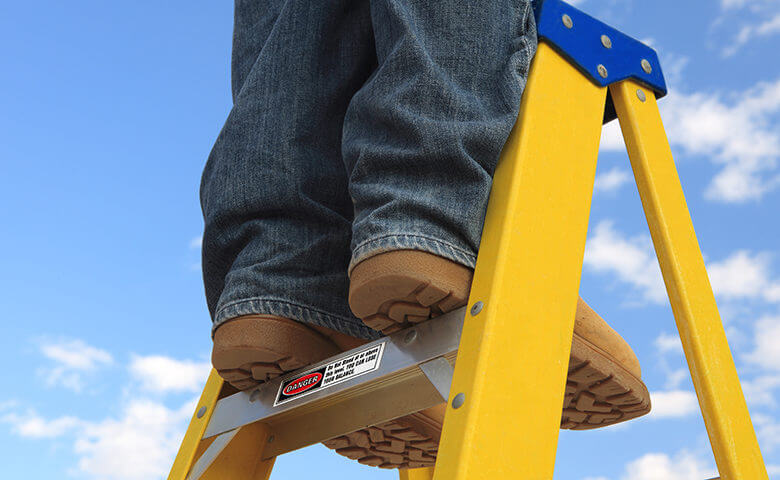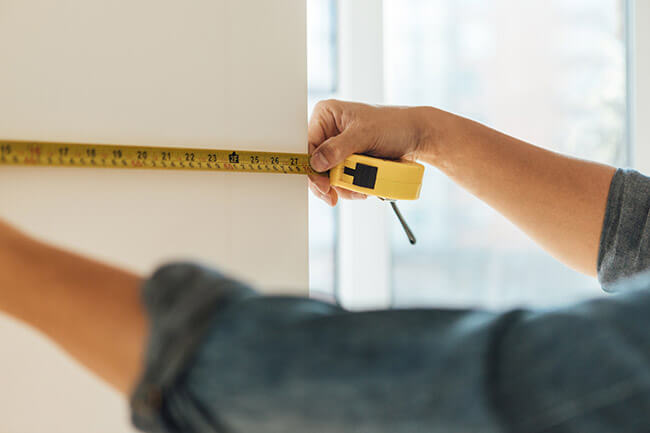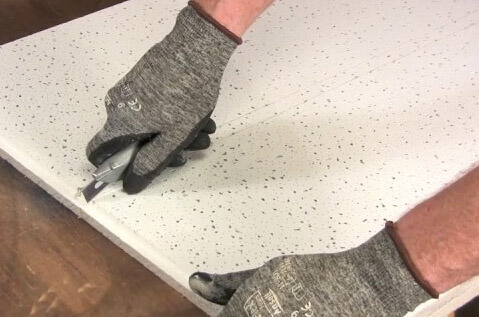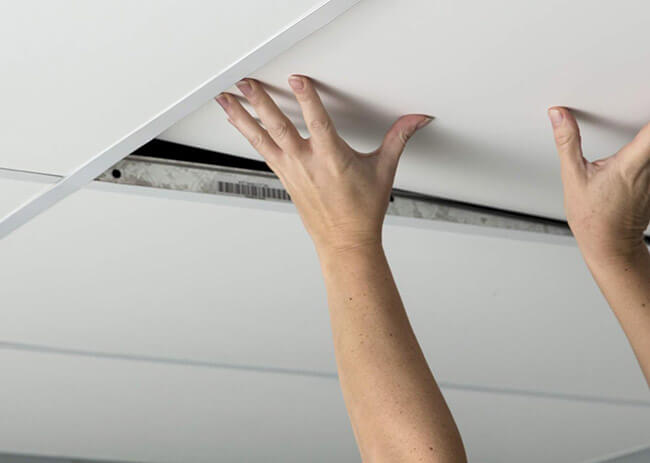How
To Choose The Right Ceiling Tiles
There’s
more to choosing the right ceiling tiles than you might first think. Which
ceiling tile is best for your application? If you’re trying to match ceiling
tiles to ones already in your ceiling, what’s the best way to do it? And if
you’re replacing an old suspended ceiling, how do you know if those are
asbestos ceiling tiles above your head?
Here’s
the Ceiling-Tiles.co.uk guide.
What size ceiling tile
should I use?
While you can find unusually shaped and sized tiles
if you really want to, there’s a reason most suspended ceiling tiles are
a standard 600mm x 600mm. Standard sizing means you can choose from a wide
range of tiles and know that they’ll fit into a standard sized ceiling grid.
Choosing a 600mm x 600mm tile also means that the
other elements you might want to slot into or above your ceiling (e.g.
lighting, insulation packs etc) will all be designed for that standard size
too.
The only exception to the above ‘rule’ is when you
choose double sized ceiling tiles (that is, 1200mm x 600mm) because they still
fit a standard grid.
You can find
our double sized tiles here.
And you can find the complete range
of our 600mm x 600mm ceiling tiles here.
What type of ceiling
tile is best?
We hate ‘it depends’ answers, but when you’re asking
‘what ceiling tile do I need?’, ‘it depends’ is the answer you’re going to get.
Which ceiling tile is best depends on what you need
your suspended ceiling to deliver. If it’s simply a case of lowering a high
ceiling or hiding pipes, cables or ceiling damage, you might choose your
ceiling tile on pure aesthetic appeal alone.
Often, however, the customers who install suspended
ceilings with us need a little more.
A ceiling suspended above a swimming pool, for
example, will need to withstand a high level of humidity to avoid sagging. This
Rockfon
Koral E24 is one tile that could do the job brilliantly. In kitchens,
easily wipeable, low- and no-texture ceiling tiles (like this British
Gypsum Satin Spar vinyl ceiling tile) can ensure that, when cleanliness is
essential to good hygiene ratings, your ceiling doesn’t let the side down.
And when you need your ceiling to help create a quieter
space, acoustic
ceiling tiles can help absorb sound within a space or prevent sound from
elsewhere causing disruption. That makes them ideal for schools, colleges,
libraries and anywhere else where peace and quiet matters.
How do I figure out how
many ceiling tiles I need?
The simplest way to calculate how many tiles your
ceiling needs is to get in touch. Give us the room dimensions and we’ll work
everything out for you, so you get just the right number of ceiling tiles to do
the job without leaving you short or with lots left over.
Contact
us here.
If you want to do the measurements yourself, do the
following. We’re using the example of a 5m x5m room using 600mm x 600mm tiles:
- 1.) Measure
the length and width of the room in metres.
- 2.) Convert
the room dimensions from meters to millimetres.
5m would be 5,000
millimetres.
- 3.) Calculate
the area of the room in square millimetres.
In a 5m x 5m room
that would be:
5,000mm × 5,000mm = 25,000,000mm
- 4.) Calculate
the area of one tile in square millimetres:
600mm × 600mm = 360,000mm
- 5.) Divide
the total area of the room by the area of one tile:
25,000,000mm /
360,000mm (or 25,000/360) = 69.44
Decide how many
lighting tiles you’ll need and remove them from the total (because you won’t
need ceiling tiles for those spaces). We’re assuming four for the purposes of
this example:
69.44 – 4 = 65.44
- 6.) Add an
extra 5%-10% to account for room edges etc, then round up.
65.44 + 10% (rounded
up) = 72
Now order your ceiling tiles.
How do you tell what
ceiling tile you have?
Once a day (at least) we’ll get a call from someone
who’s had a suspended ceiling in place for years. Now, the ceiling has suffered
damage — usually a water leak — and they want to replace the damaged tiles with
new ones. But how to identify ceiling tiles?
At first glance, ceiling tiles can look pretty
similar, but put one manufacturer’s tile next to another (or even compare different
models of the same manufacturer’s tiles) and you’ll notice slightly different
shading, different textures, edging and fissures. So how do you match ceiling
tiles so that the new ones don’t stand out from the old ones?
To find out which ceiling tile you need:
Look at the back of the tile. Some (although
frustratingly, not all) manufacturers give full details.
If the details are clear, find your
replacement ceiling tiles here.
Alternatively, if you’re still unsure what tiles you
have, send us any details you can ( a picture of the front and rear would be
good), message
us or call us.
How to identify
asbestos ceiling tiles
Asbestos
was something of a wonder material when it was first introduced in the 1920s.
It was strong, cheap, a brilliant insulator and it was easy to incorporate in
everything from insulation to roofing to cladding to (you guessed it) suspended
ceiling tiles.
There
was just one problem: asbestos was (and is) a killer. The fibres were
eventually discovered to cause serious diseases including asbestosis,
mesothelioma and lung cancer. At the peak, there were around 5,000 deaths from
asbestos-related causes each year in the UK. It took far too long, but
eventually asbestos was banned.
Suspended
ceiling tiles are no longer made using asbestos. They’ve been banned completely
since 1999 and were outlawed in home construction in 1985.
So,
if your home or business was built after 1999, it’s a virtual certainty that
your tiled ceiling doesn’t contain asbestos.
If
it was built between 1985 and 1999, it probably doesn’t contain asbestos
ceiling tiles because the construction company wouldn’t have been able to use
them (but that wouldn’t have stopped someone else installing asbestos ceiling
tiles).
And
if the ceiling was installed in any non-new build property prior to 1999, the
tiles might contain asbestos. The older the tile, the higher the chance.
It’s
not easy to identify ceiling tiles that contain asbestos from ones that don’t.
There are some giveaways — many older tiles were 9” x 9” (modern tiles are
600mm x 600mm) and these will usually contain asbestos. You may also notice a
powdery residue on the surface of the tile — but just because these traits
aren’t present doesn’t mean the tile doesn’t contain asbestos.
If
you think your tiles may contain asbestos:
•
Leave
them alone — unless the suspended ceiling tile is cracked or otherwise damaged,
it shouldn’t pose a risk.
•
Don’t
break them, saw them, remove them or dispose of them — asbestos is classed as
hazardous waste and needs specialist removal, and doing it yourself may release
harmful asbestos fibres into the air.
•
Contact
an asbestos survey or removal service.
Then, choose your new ceiling tiles
with us.
Can I use polystyrene
ceiling tiles?
You
can, but we wouldn’t advise it. Modern polystyrene ceiling tiles are certainly
cheap, but they’re flimsy and easily damaged. Older tiles in particular can
also be a fire hazard.
Given
that ceiling tiles are low cost anyway (especially when you choose them from
us), we’d always recommend a better ceiling tile that offers far better
insulation, fire resistance, bacterial or humidity resistance, that’s far more
durable and that looks infinitely better.
All
of which is why we don’t stock polystyrene ceiling tiles.
Do
you stock stick-on ceiling tiles?
We
don’t. Stick-on ceiling tiles tend to be vinyl and are used solely for
decorative effect. They don’t offer the insulation, fire resistance,
soundproofing or other benefits of suspended ceiling tiles and, if we’re
completely honest, we’re not wild about the phthalate gas they release. That’s
the distinctive vinyl smell you get when you unwrap or unfold anything from
plastic refuse sacks to kids’ paddling pools.
What are the best
ceiling tiles for bathrooms?
Humidity is the
challenge in bathrooms. Cover your suspended ceiling with tiles that don’t have
a high humidity resistance and you’ll risk the tiles acting like a sponge. Over
time, that means they’ll start to sag and look unsightly (at best). At worst,
all the stagnant water sitting within the fibres of the ceiling tile could be
an invitation for mould to grow.
To find the best
ceiling tiles for bathrooms, look for tiles with a high RH value. The higher
the RH (relative humidity) value, the better the tile will be able to resist the
condensation that’s an inevitable part of most bathrooms.
Look for tiles with an
RH value of 95% or higher for the best performance in bathrooms. This Ecophon
Advantage A tile will do the job perfectly, but for other options, explore our complete range
or contact
us.
Note: No humidity
resistant ceiling tile is waterproof. They’re designed to withstand humid
environments, but they’re not suitable for submerged applications and they
won’t appreciate having a shower head directed at them!
What are the best
ceiling tiles for schools?
It stands to reason
that a noisy, echoey classroom is likely to be a less suitable environment for
learning than a quiet space. There’s actually good evidence to back that up,
with a direct relationship between noise levels and student performance. The more
noise disrupts, the more test scores deteriorate.
It’s also the case that
too many hard surfaces in a classroom can cause sound to bounce around. Even
when volume isn’t a problem, this can make it hard for some children to pick
out and understand one sound (e.g. the teacher), from the other noise and echoes
around them.
It’s important, then,
to create a better acoustic environment, and while your ceiling isn’t the only
contributing factor, it can certainly make a big difference.
The way to achieve it
is with acoustic ceiling tiles. These are tiles made of materials that absorb
sound that hits the surface rather than reflecting it back into the room. Any
acoustic tile will help not just to deaden the sound within a space, but also
inhibit sound from above from tracking through and adding to the noise
pollution in a classroom or other quiet area.
Find the right
acoustic ceiling tile for your environment here, or for help, please
get in touch.
What are the best
ceiling tiles for offices?
Each office presents
different challenges. In some, sound is a problem. As with schools, reducing
noise ‘clutter’ with acoustic ceiling
tiles can help everyone working in the office concentrate more easily, hear
what’s being said, and distinguish one sound from another.
In other offices, light
can be a challenge. Here, any white ceiling tile can help to brighten the
environment. Metal
ceiling tiles can be particularly good at this but too much light (or light
in the wrong places) can cause a different set of problems.
In these situations,
textured ceiling tiles or metal ceiling tiles with perforations are ideal for
helping to scatter light and reduce glare.
What are the best
ceiling tiles for takeaways?
We’ve
all been in takeaways where the discoloured ceiling tiles are a dead giveaway
that hygiene standards might not be all they should be. The truth is, however,
that your takeaway could be a 5* outlet with impeccable standards, but if
you’ve got the wrong ceiling tiles above your griddles, fryers and ovens,
you’ll never be able to keep them looking pristine. That’s because highly
textured or fissured tiles offer too many nooks and crannies for grease to
cling to, and they’re virtually impossible to clean sufficiently.
That’s
why, if you run a kitchen, you’ll want to choose easily wipeable ceiling tiles,
so you can keep them as clean as every other part of your kitchen.
We’d
recommend these vinyl
ceiling tiles.
Talk
to Ceiling-Tiles.co.uk
In
a hurry? If you’d rather not search for the right ceiling tiles for your
application, just call or email us and we’ll point you in the right direction,
fast. And you’ll always get a great deal.
Please contact us today for more information.

.jpg)









